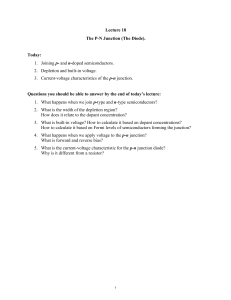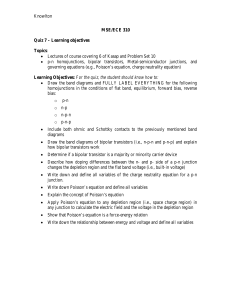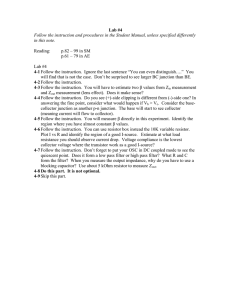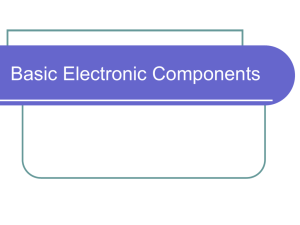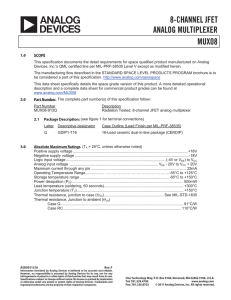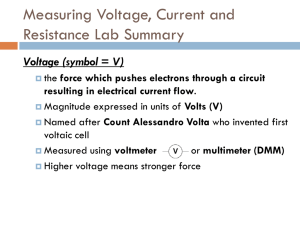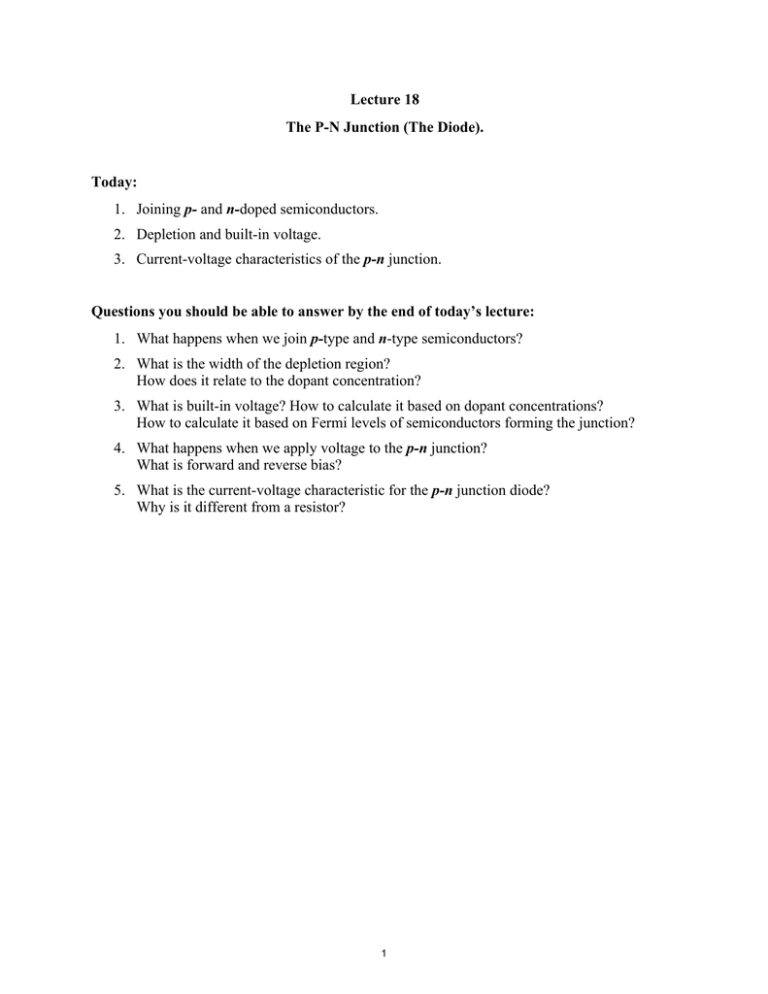
Lecture 18
The P-N Junction (The Diode).
Today:
1. Joining p- and n-doped semiconductors.
2. Depletion and built-in voltage.
3. Current-voltage characteristics of the p-n junction.
Questions you should be able to answer by the end of today’s lecture:
1. What happens when we join p-type and n-type semiconductors?
2. What is the width of the depletion region?
How does it relate to the dopant concentration?
3. What is built-in voltage? How to calculate it based on dopant concentrations?
How to calculate it based on Fermi levels of semiconductors forming the junction?
4. What happens when we apply voltage to the p-n junction?
What is forward and reverse bias?
5. What is the current-voltage characteristic for the p-n junction diode?
Why is it different from a resistor?
1
From previous lecture we remember:
What happens when you join p-doped and n-doped pieces of semiconductor together?
When materials are put in contact the carriers flow under driving force of diffusion until
chemical potential on both sides equilibrates, which would mean that the position of the Fermi
level must be the same in both p and n sides. This results in band bending:
-
Holes diffuse
-
+
+ +
+
Electrons diffuse
The electrons will diffuse into p-type material where they will recombine with holes (fill in
holes). And holes will diffuse into the n-type materials where they will recombine with electrons.
2
This means that eventually in vicinity of the junction all free carriers will be depleted leaving
stripped ions behind, which would produce an electric field across the junction:
The electric field results from the deviation from charge neutrality in the vicinity of the junction.
𝜀=
1 𝑑 𝐸c
𝑞 𝑑𝑥
Here dEc is the change in the energy of the conduction band across the junction.
A steady-state balance of carriers is achieved at the junction where diffusive flux of the carriers
is balanced by the drift flux.
The loss of charge neutrality at the junction can be also expressed in terms of the potential,
which is referred to as built-in voltage Vbi.
Using the density of the ionized donors at the junction (also referred to as space charge) ρ (x) we
can calculate the built-in voltage and the electric field at the junction.
ρ ( x)
dx
εrε 0
, where ε rε 0 is a dielectric constant.
Vbi = − ∫ ε ( x ) dx
ε=
∫
The region in the vicinity of the junction, which has been depleted of the free charge carriers is
called “depletion region”. The width of the depletion region is:
3
W=
2εrε 0Vbi N A + N D
q
NA ND
The width of the depleted n-type region (which is left positively charged):
xn =
2εrε 0Vbi
NA
q
ND (NA + ND )
The width of the depleted p-type region (which is left negatively charged):
xp =
2εrε 0Vbi
ND
q
NA (NA + ND )
Consequently: N A x p = N D xn
This means that at the junction higher doped material will have narrower depletion region
and lower doped material will have wider depletion region.
4
What is the built-in voltage Vbi?
Built-in voltage is simply the difference of the Fermi levels in p- and n-type semiconductors
before they were joined.
qVbi = EFn − EFp
"N %
EFp = EFi − kBT ln $ A '
# ni &
"N %
EFn = EFi + kBT ln $ D '
# ni &
Then we can express the built-in voltage in terms of the doping concentrations:
k T !N N $
Vbi = B ln # A 2 D &
q
" ni %
Electrons that move from n-type to p-type or holes moving in the opposite direction are called
minority carriers (holes inside n-type or electrons in p-type). Using equations above we can
show that qVbi is the barrier to minority carrier injection:
−qVbi
pn = p p e kBT
n p = nn e
−qVbi
k BT
5
Example: Doping GaAs
Figure removed due to copyright restrictions. Fig. 4.14: Unknown source.
Vbi =
k BT ! N A N D $
ln # 2 &
q
" ni %
𝑁!"(!) = 10!"
1
𝑐𝑚!
𝑁!"(!) = 10!"
1
𝑐𝑚!
𝑛!! !"#$ !""! = 10!"
Figure removed due to copyright restrictions.
Fig. 2.20: Pierret, Robert F. Semiconductor
Fundamentals. 2nd ed. Prentice Hall, 1988.
𝑉!" = 0.025ln
6
10!"
= 1.15𝑉
10!"
Effect of Applied Voltage - Bias:
When we apply forward bias (positive voltage to p-type, negative voltage to n-type) it effectively
reduces the built-in voltage. When we apply reverse bias (positive voltage to n-type, negative
voltage to p-type) it effectively increases the built-in voltage.
• Applying a potential to the ends of a diode does NOT increase current through drift rather it
lowers the potential barrier to diffusion.
• The applied voltage upsets the steady-state balance between drift and diffusion, which
unleashes the flow of diffusion current.
• Since the conduction through the junction happens via minority carriers, the p-n junction is
called a “Minority carrier device.”
• Forward bias decreases depletion region and also increases diffusion current exponentially.
• Reverse bias increases depletion region, and in ideal case there is no current flow.
7
If we solve the minority carrier drift and diffusion equations:
dn
dx ,
dp
J p = qµ p pε − qDp
dx
Where Dn and Dp are electron and hole minority carrier diffusion constants.
J n = qµ n nε − qDn
We can find the total dependence of the current through the junction on the applied bias voltage:
! qVa $
! D n 2 D n 2 $! qVa $
J = q ## n i + p i &&## e kBT −1&& = J s ## e kBT −1&& ,
" Ln N A L p N D %"
%
"
%
Here Ln, p = Dn, pτ n, p are diffusion lengths for the minority carriers.
Since the p-n junction demonstrates such a unipolar (rectifying) response to the applied voltage it
is called a p-n diode and is denoted in circuit diagrams as a following symbol:
The current voltage (IV) characteristic for the diode is rectifying and is very different from that
for a resistor.
8
Ideal Diode I-V Characteristics
𝐽 =𝐽 +𝐽 =𝐽
𝑒 − 1
Figure removed due to copyright restrictions. See Fig. 15.1-18(c): Saleh, Bahaa
E. A., and Malvin Carl Teich. Fundamentals of Photonics. 2nd ed. Wiley, 2007.
What kind of devices can we build using p-n junctions?
•
P-N junctions under applied voltage: diodes, transistors, light-emitting devices, and lasers.
•
P-N junctions under illumination: solar cells, photodetectors.
Before we can design p-n junction devices that couple electricity to light and vice versa we need
to understand concepts of carrier generation and recombination.
Carrier generation. Photovoltaic cells.
The two most common mechanisms for carrier generation in semiconductors are thermal
generation and photogeneration. Thermal generation is a standard mechanism for promotion of
the electrons from valence to conduction bands, which is just a result of Fermi distribution
broadening at higher temperatures.
Heat
(phonons)
Photon
Thermal Generation
Photogeneration
Image by MIT OpenCourseWare.
The second mechanism – photogeneration is more exciting as it involves an interaction of an
electron with a photon, which results in electron being promoted into conduction band leaving
behind a hole. In other words, absorption of a photon by a material results in a generation
of an electron-hole pair.
9
Let’s focus on photogeneration and it’s application to photodetectors and photovoltaics.
The photogeneration is a direct consequence of absorption of a photon. The absorption rate is
highly dependent on the type of semiconductor.
• Direct bandgap semiconductors:
The top of the valence band aligns with the
bottom of the conduction band in k-space.
In this case the material can absorb any
photon with the energy equal or larger than
the bandgap.
• Indirect bandgap semiconductors:
The top of the valence band is shifted from the
bottom of the conduction band in k-space.
In these materials photons with energies
between the bandgap and the vertical gap can
only be absorbed in the presence of a lattice
vibration (a phonon), which can donate its
momentum towards the optical transition.
In direct bandgap semiconductors:
Ecelectron = Evelectron + ω, ω ≥ Eg
In indirect bandgap semiconductors:
" electron
= Evelectron + ω + E phonon , Eg ≤ ω ≤ Evertical
$ Ec
#
kcelectron = kvelectron + p phonon
%$
E
electron
c
=E
and
+ ω, ω ≥ Evertical
electron
v
Figure removed due to copyright restrictions. Figs. 4-5: Kittel, Charles.
Introduction to Solid State Physics. 8th ed. Wiley, 2004, p. 202.
10
Photogeneration rate G [electrons/sec] is proportional to the number of incident photons, which
are generally measured as photon flux φ (photons/sec). In a simplest approximation we can say
that generation rate G can be found as:
G~
absorbed photons
= α ⋅ φ , where α is absorption coefficient and φ is a photon flux.
sec
In reality, however, there are many factors (geometry, interactions with phonons etc.)
contributing to the efficiency of conversion of photon into electron-hole pairs and the generation
rate can be written as:
G = α ⋅ φ ⋅ η , where η is the efficiency coefficient, which is generally measured experimentally.
So what happens when light with the energy above the bandgap shines onto the p-n
junction diode?
Outside the depletion region photogenerated electrons can easily fall back onto valence band or
“recombine” with their holes unless they diffuse into the depletion region.
Remember that within the depletion region there is a built-in potential, or an electric field, which
would immediately sweep the photogenerated holes and electrons into opposite directions. This
means that the carriers generated within the depletion region or those that have diffused into the
depletion region will be pushed by the field into the bulk of the material (holes into the p-side
and electrons into the n-side).
•
When electron-hole pairs approach the junction they are pulled apart by the built-in field.
•
Electrons are pushed into the n-side and holes are pushed into the p-side.
11
• If we connect p-side to n-side (i.e. make a short
circuit), then these carriers will flow at zero applied
voltage (just under built-in voltage). This means we
will observe short-circuit current called photocurrent
Jph.
• If we isolate the contacts the carriers accumulating
on p and n sides would eventually lead to a potential
build-up (effectively lowering built-in voltage), which
would increase the dark current through the diode
cancelling the photocurrent Jph=Jcs. This potential is
called open-circuit voltage Voc.
• If we plot current-voltage characteristics for the p-n
diode under illumination it will look shifted down by
Jph=Jsc.
Current-voltage characteristic for a diode:
J dark
" eVa %
= J s $$ e kBT −1''
#
&
Current-voltage characteristic for a diode under illumination:
Jlight
" eVa %
= J dark − J ph = J s $$ e kBT −1'' − J ph
#
&
Solving for voltage in the open-circuit regime we find Voc:
" eVa %
%
k T "J
$
J oc = J dark − J ph = J s $ e kBT −1'' − J sc = 0 ⇒ Voc = B ln $ sc +1'
e
# Js
&
#
&
Characteristics of solar cells:
1. Fill Factor (FF).
How do we extract energy out of a solar cell? The only way to do it currently is by attaching
a load to it (the simplest example is a resistor).
It turns out that the resistance of the load is crucial to how much power one can possibly
extract from a solar cell.
Recall that for the resistor the power is given by the following expression: P = J 2 ⋅ R = V ⋅ J
If we plot it in the I-V plot, the power will be the area of the rectangle formed by the values
of I and V. Now take a closer look at the I-V characteristic of the solar cell. The only power
we can extract would be a rectangle that fits between the Voc and Jsc. There are a lot of those
12
rectangles but we can find the one that maximizes the area, i.e. maximizes the extracted
power:
Pmax = J mpVmp
Hence, the optimum load has the resistance that satisfies: Rmp =
Vmp
I mp
Obviously, we would like to be able to extract as much power as possible from a solar cell,
hence it is beneficial to have the space between the Voc and Jsc to be as close to the rectangle
between the Vmp and Imp as possible. The parameter that defines that is called a fill factor
(FF):
FF =
2.
Vmp J mp
Voc J sc
Power conversion efficiency:
The power conversion efficiency is simply the ratio of the extracted power to the power of
the incident light (optical power):
η power =
Vmp J mp
V J
= FF oc sc
Poptical
Poptical
3. Quantum efficiency:
While power conversion efficiency is used in the industrial setting, solar cell designers and
researchers are generally interested in the intrinsic behavior of the solar cell, i.e. how many
electrons does the solar cell produce per one incident photon.
Internal quantum efficiency (IQE) is the property of the solar cell design rather then the
material used to fabricate the cell, i.e. IQE is normalized to the material absorption:
IQE = ηint =
electrons out
photons absorbed
External quantum efficiency (EQE)
combines the properties of the cell
design and the ability of the material to
absorb:
EQE = ηex =
electrons out
photons in
13
The plot above demonstrates the difference between IQE and EQE. EQE takes into account
material reflectance spectrum, i.e. it takes into account the fact that material does not absorb
a number of photons but rather reflects them.
EQE is a standard characteristic generally used in scientific papers to describe the quality of
a novel solar cell material or design as it reflects all the material and design properties
(absorption, photon-to-electron efficiency, recombination processes, electron extraction
efficiency etc.).
In order to calculate find EQE we generally use a light source with a known spectrum and
power (usually “Solar Simulator” – a light source simulating solar spectrum) we then record
IV-characteristics for the solar cell under illumination and compare it to the IV-characteristic
without the light.
If we know the light power
[W] at a wavelength
, where
If we know the collected current
, then flux
is:
is the Planck constant and
is the speed of light.
[A], then the number of electrons is:
Then we can calculate the EQE of the solar cell:
NREL compilation of best research solar cell efficiencies. (This image is in the public domain. Source:
Wikimedia Commons.)
Recombination processes decreasing the efficiency of solar cells:
(a) Band-to-band recombination:
Electron-hole pair generated by an
absorption event recombines directly
emitting a photon. Electron returns to the
valence band and “fills” the hole.
(b) R–G center recombination.
If there are energy levels (states) inside
the bandgap. These levels can act as
recombination-generation (R–G) centers.
Electrons can jump down into these lower
energy states releasing excess energy as
heat (lattice vibrations = phonons).
(c) Recombination via shallow levels.
If there are exist energy levels inside the
bandgap close to the conduction or
valence band electrons or holes can jump
onto these levels and then recombine with
each other releasing the electron energy as
a photon. (This process is something in
between (a) and (b)).
(d) Recombination involving excitons.
This recombination process is analogous
to band-to-band recombination except
here electron and hole first form a bound
pair – exciton with the energy slightly
lower than that of the bandgap. Excitons
behave similarly to a hydrogen atom,
where hole acts as a nucleus with electron
bound to it.
(e) Auger recombination.
This mechanism involves an additional
electron. Here energy released during e-h
recombination is used to promote the
other electron onto higher energy level,
from which it then falls down releasing
energy as heat.
© source unknown. All rights reserved. This content is excluded from our Creative
Commons license. For more information, see http://ocw.mit.edu/help/faq-fair-use/.
15
MIT OpenCourseWare
http://ocw.mit.edu
3.024 Electronic, Optical and Magnetic Properties of Materials
Spring 2013
For information about citing these materials or our Terms of Use, visit: http://ocw.mit.edu/terms.



